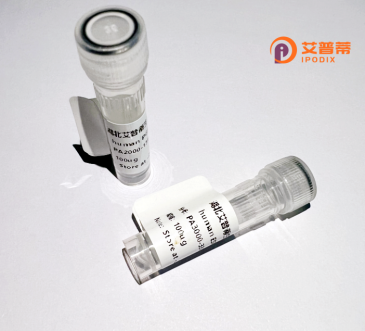
| 纯度 | >90%SDS-PAGE. |
| 种属 | Human |
| 靶点 | MMS19L |
| Uniprot No | Q96T76 |
| 内毒素 | < 0.01EU/μg |
| 表达宿主 | E.coli |
| 表达区间 | 1-293 aa |
| 活性数据 | MRELLELSCCHSCPFSSTAAAKCFAGLLNKHPAGQQLDEFLQLAVDKVEAGLGSGPCRSQAFTLLLWVTKALVLRYHPLSSCLTARLMGLLSDPELGPAAADGFSLLMSDCTDVLTRAGHAEVRIMFRQRFFTDNVPALVQGFHAAPPDVKPNYLKGLSHVLNRLPKPVLLPELPTLLSLLLEALSCPDCVVQLSTLSCLQPLLLEAPQVMSLHVDTLVTKFLNLSSSPSMAVRIAALQCMHALTRLPTPVLLPYKPQVIRALAKSLDDKKRLVRKEAVSARGEWFLLGSPGS |
| 分子量 | 57.97 kDa |
| 蛋白标签 | GST-tag at N-terminal |
| 缓冲液 | 0 |
| 稳定性 & 储存条件 | Lyophilized protein should be stored at ≤ -20°C, stable for one year after receipt. Reconstituted protein solution can be stored at 2-8°C for 2-7 days. Aliquots of reconstituted samples are stable at ≤ -20°C for 3 months. |
| 复溶 | Always centrifuge tubes before opening.Do not mix by vortex or pipetting. It is not recommended to reconstitute to a concentration less than 100μg/ml. Dissolve the lyophilized protein in distilled water. Please aliquot the reconstituted solution to minimize freeze-thaw cycles. |
以下是关于人 **MMS19L蛋白** 的3篇参考文献及其摘要概述:
---
1. **文献名称**:*MMS19 assembles iron-sulfur proteins required for DNA metabolism and genomic integrity*
**作者**:Gari K, et al.
**摘要**:
该研究揭示了MMS19L(人源MMS19同源物)与CIA(细胞质铁硫组装)复合物的其他成员(如CIAO1、FAM96B)相互作用,参与将铁硫簇递送至DNA修复和复制相关的酶(如DNA聚合酶和核酸内切酶),维持基因组稳定性。
2. **文献名称**:*Structure-function analysis of the MMS19 protein in the cytoplasmic iron-sulfur cluster assembly pathway*
**作者**:Stehling O, et al.
**摘要**:
通过结构分析,研究指出MMS19L作为CIA复合体的关键组分,通过其C端结构域结合目标蛋白(如XRCC1、FANCJ),并协调铁硫簇的插入,支持DNA损伤应答中的酶活性。
3. **文献名称**:*Mitochondrial iron-sulfur protein biogenesis and its emerging roles in cancer*
**作者**:Chen L, et al.
**摘要**:
文章综述了MMS19L在线粒体铁硫蛋白生物发生中的作用,指出其表达异常可能与癌症相关代谢失调有关,尤其是在维持线粒体呼吸链复合体活性中的间接调控功能。
---
**说明**:MMS19L研究多聚焦于其参与铁硫簇组装(CIA途径)及DNA修复机制,上述文献涵盖功能解析、结构分析及疾病关联,需查阅具体文章获取细节。
The MMS19L (Methyl Methane Sulfonate Sensitivity 19-Like) protein is a eukaryotic homolog of the yeast MMS19 protein, which is evolutionarily conserved and plays roles in genome stability and DNA repair pathways. In humans, MMS19L forms part of the conserved metazoan-specific MMS19-MIP18-XPD (MMXD) complex, contributing to iron-sulfur (Fe-S) cluster assembly and trafficking. This complex is crucial for DNA repair mechanisms, including nucleotide excision repair (NER) and interstrand crosslink repair, as well as maintaining telomere integrity. MMS19L interacts with proteins involved in transcription, chromatin remodeling, and replication stress response, linking it to cellular processes like transcription elongation and replication fork progression.
Dysregulation of MMS19L has been associated with genomic instability, accelerated aging, and cancer progression. Studies suggest its role in tumorigenesis, where mutations or altered expression may impair Fe-S cluster biogenesis, affecting DNA repair enzymes (e.g., DNA polymerases and helicases). As a recombinant protein, MMS19L is produced in vitro for functional studies, enabling exploration of its structure, interactions, and role in Fe-S enzyme maturation. Recombinant systems (e.g., E. coli or mammalian cell lines) allow biochemical characterization and high-throughput screening for potential therapeutic targets in diseases linked to DNA repair defects or Fe-S cluster deficiencies. Current research focuses on elucidating its precise molecular mechanisms and therapeutic potential in oncology and age-related disorders.
×